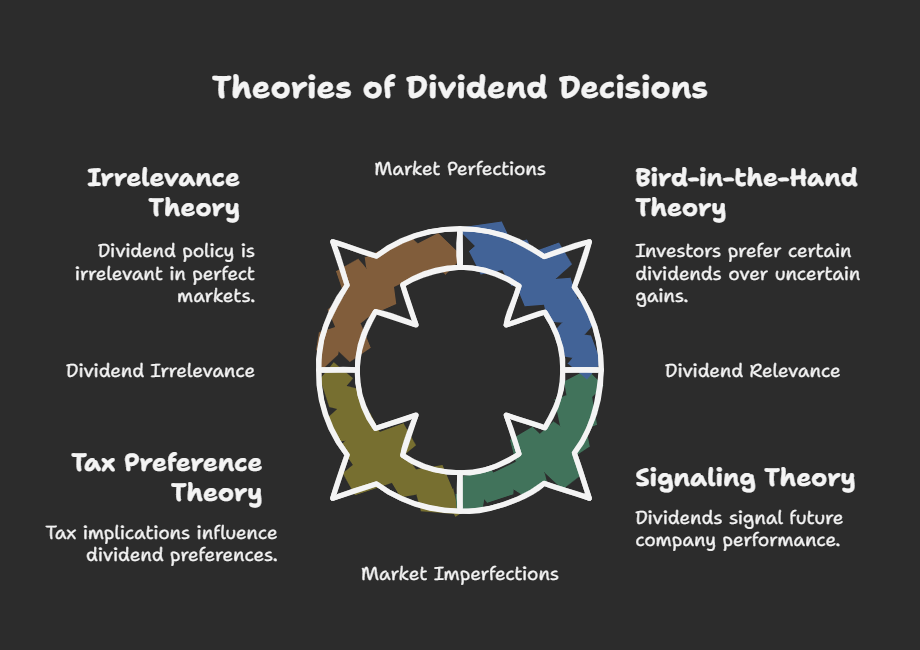Theories of dividend decision , determinants , companies act 2013
V. Theories of Dividend Decisions
 A. Irrelevance Theory (Modigliani and Miller - MM):
A. Irrelevance Theory (Modigliani and Miller - MM):
- Core Idea: Dividend policy is irrelevant under perfect market conditions (no taxes, transaction costs, perfect information). Investors can create "homemade dividends."
- Assumptions: Perfect markets, rational investors, no taxes, no transaction costs, fixed investment policy.
- Criticisms: Real world is not perfect; taxes, transaction costs, and information asymmetry exist.
B. Relevance Theories: Dividend policy matters.
-
Walter's Model:
- Core Idea: Optimal dividend policy depends on the relationship between the firm's internal rate of return (r) and the cost of capital (k).
- If r > k: Growth firm; retain earnings (0% payout).
- If r = k: Indifference; dividend policy doesn't matter.
- If r < k: Declining firm; pay out all earnings (100% payout).
-
Formula: P = (D + (E-D) * (r/ke)) / ke
- P = Market Price per share
- D = Dividend per share
- E = Earnings per share
- r = firm's rate of return
- ke = Cost of Equity Capital
-
Gordon's Model (Dividend Discount Model - DDM):
- Core Idea: Value of stock is the present value of expected future dividends.
-
Formula: P0 = D1 / (ke - g)
- P0 = Current price
- D1 = Expected dividend next year
- ke = Required rate of return
- g = Constant growth rate of dividends
- Implication: Higher dividends and growth = higher stock price.
- Criticisms: Assumes constant growth rate, sensitive to inputs (ke and g).
-
Bird-in-the-Hand Theory (Myron Gordon and John Lintner):
- Core Idea: Investors prefer current dividends ("bird in the hand") over uncertain future capital gains.
- Rationale: Dividends reduce uncertainty.
- Implication: Higher dividends = higher stock price.
- Criticisms: Contradicts MM irrelevance theory.
C. Tax Preference Theory:
- Core Idea: Dividend policy influenced by tax implications for investors.
- Rationale: If dividends taxed higher than capital gains, investors prefer retained earnings.
- Empirical Evidence: Mixed, tax laws vary.
D. Signaling Theory (Dividend Signaling):
- Core Idea: Dividends convey information about future prospects.
- Rationale: Management has inside information.
- Implication: Dividend increase is a credible signal of higher future earnings. Dividend decrease is negative.
V. Determinants of Dividend Policy Decisions
- Profitability: Sufficient profits to pay dividends.
- Liquidity: Sufficient cash for distribution.
- Investment Opportunities: Attractive projects may lead to retaining earnings.
- Financial Leverage (Debt): High debt may restrict dividend payments.
- Growth Rate: High-growth companies often retain earnings.
- Shareholder Preferences: Consider preferences for dividends vs. capital gains.
- Legal Restrictions: Companies Act and other regulations.
- Contractual Restrictions: Loan agreements may restrict payments.
- Inflation: High inflation reduces real value of dividends, restricting policy.
- Stability of Earnings: Stable earnings lead to higher payouts.
- Access to Capital Markets: Easy access encourages distribution.
- Control Objective: Stock dividends maintain control.
- Taxation: Significant effect on dividend policy.
VI. Companies Act, 2013 and SEBI Guidelines on Dividend Distribution (Theory Only)
A. Companies Act, 2013 (Key Provisions):
-
Section 123: Declaration of dividends.
- Out of current profits, past accumulated profits, or money from government.
- Depreciation must be provided for.
- Board can transfer profits to reserves.
- Inadequacy of profits: dividends can be declared from accumulated profits subject to rules.
-
Section 124: Unpaid Dividend Account.
- Unpaid/unclaimed dividends within 30 days go to Unpaid Dividend Account.
- Unclaimed for 7 years, transferred to Investor Education and Protection Fund (IEPF).
- Interim Dividend: Board can declare interim dividends.
B. SEBI (Securities and Exchange Board of India) Guidelines on Dividend Distribution (Listed Companies):
- Listing Agreement/Regulations: Mandates disclosures and procedures.
-
Disclosure Requirements:
- Dividend amount, record date, payment date.
- Reasons for changes in policy.
- Record Date: Announce record date for eligibility.
- Payment Timeline: Adhere to timeline after declaration.
- Dividend Warrants/Electronic Transfer: Payment methods.
- Compliance with Accounting Standards: Dividend distribution must comply.
- Regulations for Bonus Issues: Specific regulations.
Important Considerations:
- Practical Application: Complex area; consider financial situation, opportunities, and shareholder preferences.
- Dynamic Nature: Review and adjust periodically.
- Consultation: Consult with advisors and legal counsel.

No Comments